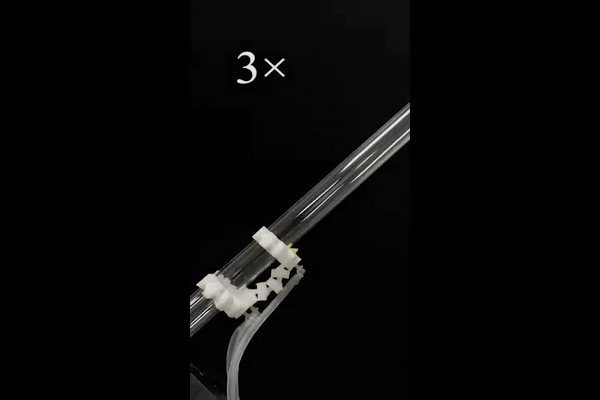


TIANJIN, Jan. 28 (Xinhua) -- A white piece of equipment was "climbing" along a round tube. With its body stretching and contracting like an inchworm, it moved forward smoothly and even passed a 90-degree angle.
The equipment is a one-piece 3D-printed pipe-climbing robot composed of sequenced novel soft bending mechanisms, which was recently developed by professor Zuo Siyang and Dr. Liu Jianbin's research team at Tianjin University in north China's Tianjin Municipality.
Though pipe-climbing robots have been used in real-time monitoring, leak inspection and other tasks, no single device boasted the ability to climb on both the inner and outer walls of a pipe.
Moreover, such robots are usually designed for specific applications with complex structures, limiting their adaptability to various conditions. They are also relatively heavy due to the hard materials they are made from.
The new design by the team of Tianjin University, however, solves the aforementioned challenges. It is composed of an upper gripper, a middle section and a lower gripper, as well as three intake pipes at the back of the robot to control the three parts.
"To trigger a 'climbing' motion, we only need to alternately pressurize and depressurize the device's grippers, and the motion is under our direct control," said Liu. The middle section elongates like an inchworm when it is pressurized and is reinstated when depressurized.
The 3D-printed soft bending mechanism uses the small strain of a non-tensile material to allow for large bending deformations and can rotate around longitudinal or lateral directions. It is also highly adaptable to pipes with various diameters, radii of curvature and inclinations, and can work both inside and outside a pipe.
Researchers used CAD software in designing the module-based device to facilitate future upgrades. "We can add modules or adjust the diameter of the device's grippers at will," said Liu.
The robot also boasts a large static bearing ability of 1,000 grams, which is almost 80 times its own weight.
In the future, researchers aim to integrate sensors into the robot, allowing it to carry out pipe maintenance independently, according to the team.

 Award-winning photos show poverty reduction achievements in NE China's Jilin province
Award-winning photos show poverty reduction achievements in NE China's Jilin province People dance to greet advent of New Year in Ameiqituo Town, Guizhou
People dance to greet advent of New Year in Ameiqituo Town, Guizhou Fire brigade in Shanghai holds group wedding
Fire brigade in Shanghai holds group wedding Tourists enjoy ice sculptures in Datan Town, north China
Tourists enjoy ice sculptures in Datan Town, north China Sunset scenery of Dayan Pagoda in Xi'an
Sunset scenery of Dayan Pagoda in Xi'an Tourists have fun at scenic spot in Nanlong Town, NW China
Tourists have fun at scenic spot in Nanlong Town, NW China Harbin attracts tourists by making best use of ice in winter
Harbin attracts tourists by making best use of ice in winter In pics: FIS Alpine Ski Women's World Cup Slalom
In pics: FIS Alpine Ski Women's World Cup Slalom Black-necked cranes rest at reservoir in Lhunzhub County, Lhasa
Black-necked cranes rest at reservoir in Lhunzhub County, Lhasa China's FAST telescope will be available to foreign scientists in April
China's FAST telescope will be available to foreign scientists in April